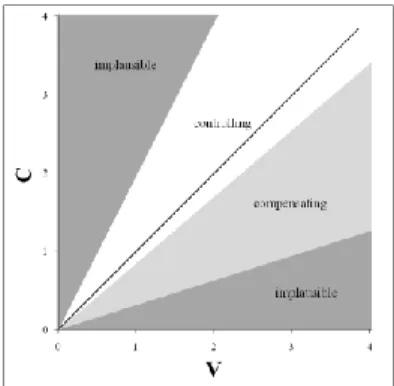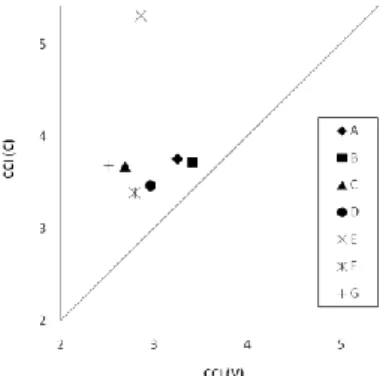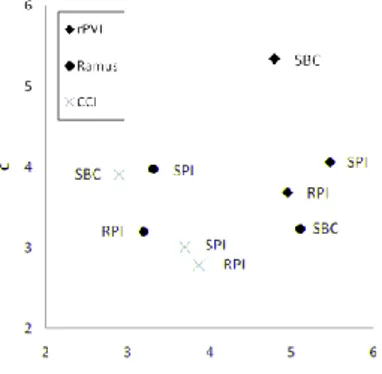MODELING THE SPEECH RHYTHM OF BEIJING CHINESE
IN THE CCI FRAMEWORK
Pier Marco Bertinetto, Chiara Bertini, Na Zhi
Laboratorio di Linguistica, Scuola Normale Superiore, Pisa, Italy
[email protected], [email protected], [email protected]
ABSTRACT
This study describes the application of CCI (Con-trol/Compensation Index) [3, 4] to a corpus of spontaneous Beijing Chinese. CCI is a modifica-tion of the PVI algorithm [8], devised to provide an improved representation of the rhythmic tenden-cies of natural languages. The CCI algorithm was previously applied to the modeling of Italian [3, 5]. The present findings refer to Beijing Chinese.
Keywords: the Control/Compensation index (CCI),
speech rhythm, spontaneous Beijing Chinese.
1. INTRODUCTION
This study is part of an ongoing project concerning the rhythmic behavior of different languages by means of the CCI algorithm, also in comparison with results obtained by other methods. In previous work [3, 4, 5], these measures were applied to cor-pora of spontaneous and read Pisa Italian, and is currently being applied to spontaneous German and Brasilian Portuguese. This paper deals with the speech rhythm of Beijing Chinese as contrasted with (Pisa) Italian.
The basic idea of CCI (Control/Compensation Index) consists of relativizing the PVI model [13] to the number of segments composing each V and C interval. The duration of each interval is divided by the number of segments in it, according to the following formula, where m stands for ‘number of intervals’ (vocalic or consonantal, as separately considered), d for ‘duration’ (in ms), n for ‘number of segments within the relevant interval’:
1 1 1 1 ) 1 ( 10 1
k k m k k k n d n d m CCIDue to its very conception, the CCI model takes into account not only the speech durational behav-ior, but also the degree of phonotactic complexity as reflected in the number of segments composing each V and C interval. The model aims at provid-ing a more realistic representation of the rhythmic tendencies of natural languages. Indeed, it makes a big difference, in terms of phonotactics, whether a
C interval contains a single C, or a geminate, or a C cluster, and the same holds for the V intervals (with a single V, a long V, or a V sequence). In ideal situations, a perfectly “controlling” language should present tendentially identical C and V local durational fluctuations, thus falling on the bisect-ing line, or at least it should exhibit stronger stabil-ity in the V intervals. By contrast, “compensating” languages should fluctuate more in the V than in the C component, for they presuppose substantial V-reduction. Fig. 1 (which modifies the initial pro-posal in [3]), depicts these ideal situations, obvi-ously to be interpreted cum grano salis. Since the use of CCI is still in the initial phase, one should allow for some approximation in the formulation of the relevant predictions.
One should keep in mind that the Con-trol/Compensation model, in its full realization, is based on a two-level conception [4]. This paper only refers to level-I (phonotactics). Future work will address level-II (phrasal), where phrase prom-inences play a rhythmically crucial role.
Figure 1: Schematic representation of the major rhythmic types according to the CCI model.
2. APPLYING CCI TO SPONTANEOUS BEIJING CHINESE
2.1. The corpus
2.1.1. Data selection
The materials used in this study are utterances stemming from the Chinese Spontaneous
Conver-sation Corpus [9, 10], produced by the Chinese
Academy of Social Sciences, Beijing. The corpus consists of 12 units of daily conversations between native Beijing speakers. Each unit is a 1-hour dia-logue between two speakers of the same gender.
For this study, 607 utterances produced by 7 speakers (4 females and 3 males) were selected from the corpus and manually labeled at the seg-mental level by one of the authors (a native speak-er).
The utterances were selected according to the same criteria used for the Italian corpus. They were tendentially neutral from the intonational point of view, and consisted of at least 8-syllables. In addi-tion, they should not present disturbing phenomena such as speakers’ overlap, laughters, background noise, etc. Moreover, each utterance-final syllable was trimmed, in order to minimize the durational distortion due to final lengthening. Finally, all sen-tence-initial syllable-onsets consisting of a plosive [p ph t th k kh] or an affricate [ts tsh tʂ tʂh ʨ ʨh] were trimmed, due to the impossibility to exactly meas-ure the initial C interval’s duration. Occasionally, even an initial nasal- [m n], liquid- [l], or fricative-onset [s f ʂ ʐ ɕ x] had to be trimmed due to very small signal energy.
2.1.2. Regular vs. irregular sound elisions
Deletions, insertions and shifts
In spontaneous speech, one can detect several un-predicted sound changes, consisting of deletions, insertions and shifts. In our corpus, deletions by far outnumbered insertions and shifts.
As for shifts, the following phenomenon de-serves particular attention. Occasionally, the pho-nological constitution of a segment was modified, such that a phonological V was realized as a C. Namely, a high back vowel /u/, as part of the nu-cleus of an onsetless syllable, was sometimes pro-duced as a labial-dental [v], especially in sequenc-es such as /uən/, /uan/, /uaŋ/, /uai/ and /uei/. One and the same speaker could interchangeably articu-late the two sounds. There are 32 such cases, while in 80 cases /u/ was not changed.
Only one case of sound-insertion was found in our data. By contrast, we found many cases of de-letion. We divide them into two categories: “regu-lar” and “irregu“regu-lar” sound deletions.
Regular sound deletions
Regular deletions involve frequent words pre-senting allomorphy, involving routine casual
speech pronunciations. Due to frequency of usage, these may become an intentional target.
We found that Beijing speakers often produce the bound morpheme 们 (a grammatical particle often used in plural personal pronouns) as m in-stead of the citational mən. E.g., uo mən ‘we’ could be realized as uo m, ta mən ‘they’ as ta m, ni mən ‘you’ (plural) as ni m. There were 63 such cases, and only 11 cases where mən was not shortened. We thus consider m an intentional deletion, due to the weak status of this plural particle in casual speech, except for instances of contrastive or em-phatic focus.
A similar case involved the bound-morpheme 么 mə, to be found in words such as 什 么 ʂən mə
(question word ‘what’), 怎 么 tsən mə (question
word ‘how’), or 那么 na mə (conjunction ‘then’).
The speakers often omitted the vowel. There were 36 such cases, and 52 cases where the citational syllable was pronounced. In sum, we considered m an acceptable pronunciation for both mən and mə.
Irregular sound deletion
Irregular deletion are cases where, due to hypo-articulation, the phonetic output did not correspond to the speaker’s phonological intention. This is strictly related to speech rate and casualness of speaking style. We found 61 cases of irregular V deletion, and 396 cases of irregular C deletion (out of which, 323 were onset deletions and 73 were coda deletions). This is not surprising, considering the relatively high speech rate in the corpus.
2.1.3. Phonetic and phonological analysis
The following table details the data selected from the corpus. By “phonological segments” we mean the intended phonemes, by “phonetic segments” the phonemes actually produced, due to irregular deletions: phonological segments phonetic segments vowels 10264 10203 consonants 6976 6580 total 17240 16783
Table 1: Number of phonological and phonetic seg-ments analyzed in this study
In the CCI model, the phonetically inaudible, but phonologically intended segments, might be assigned zero duration, for one may assume that they were part of the speaker’s articulatory plan, irrespective of the actual phonetic output.
Howev-er, we performed a double computation: “phono-logical” and “phonetic”. In the latter case, only the actually produced segments were taken into ac-count.
2.1.4. Vowel clusters
In previous studies on Chinese syllable structure [1, 2, 6, 7, 11, 12, 13], no final agreement was reached on the phonological status of the initial segment /i/, /y/ or /u/ in multi-vowel sequences such as /ia/, /iau/, /iou/, /ya/, /ye/, /yu/, /ua/, /uo/, /uə/, /uai/, /uei/. When the initial segment is /i y/, there ap-pears to be no convincing evidence to consider it a glide. We thus regard the relevant diphthongs and triphthongs as V sequences, and treat all segments involved as belonging to a tautosyllabic V interval. In other words, since all Vs in such sequences be-long to one and the same syllable, they do not give rise to a hiatus (which in the CCI model would in-volve two adjacent V intervals).
As for the V sequences beginning with /u/, the latter segment may correspond (as noted in § 2.1.2) to two alternative phonological categories: either the vowel /u/, or the consonant /v/. In the CCI computations, we considered such [u] and [v] as belonging to a V or C interval, respectively. In the latter case, a citational two/three-vowel sequence was treated as a CV(V) sequence.
The number of two- and three-vowel sequences in our corpus was 2360 and 626, respectively. Their sum amounts to 45.0% of the V intervals. They thus represent a very substantial phonotactic component. By contrast, the number of Italian diphthongs was 145, i.e. 5.2% of the V intervals (in all, there were 2870 V and 3621 C segments). Since the glide status of the relevant segments is universally admitted for Italian, they were assigned to the preceding or following C interval. However, in order to better compare our present and previous results, we ran a further analysis (cf. SPI/v-v in fig. 2), where such segments were treated as part of the V interval, in analogy with the Chinese data.
3. Results and comparison
In contrast to Italian, Beijing Chinese falls, accord-ing to the CCI computations, to the left of the bi-secting line (fig. 2). This indicates a strongly con-trolling behavior. Interestingly, this arises despite the presence of so many two- and three-V se-quences, which might in principle introduce a great deal of compression among the relevant V seg-ments. Despite this, and despite the virtual absence
of C clusters, there is more “local fluctuation” (as measured by CCI, in analogy with PVI) in the C than in the V intervals. This is evidently due to the longer duration of aspirated consonants as opposed to non-aspirated ones. The higher stability of the V as opposed to the C component is a strong indica-tion of a controlling tendency, particularly evident in the phonological analysis (cf. § 2.1.3), due to the non-negligible number of irregular C deletions. No substantial difference emerged, by contrast, be-tween the SPI and SPI/v-v analyses.
Figure 2: Rhythmic tendencies of Spontaneous Bei-jing Chinese (SBC) in two analyses (phonological and
phonetic), Read Pisa Italian (RPI) and Spontaneous
Pisa Italian (with glides assigned to C intervals [SPI] or V intervals [SPI/v-v]).
The disaggregated behavior of the individual speakers is shown in figure 3. As it happens, apart from one speaker (but limited to the C component), there was considerable inter-individual consistency:
Figure 3: Individual differences of speech rhythm. Capitals from A to G indicate the 7 Beijing speakers.
Speech rate is known to exert a crucial role in the rhythmical behavior of natural languages, as often noted in the specialized literature. To check for this factor, the Beijing speakers’ productions were divided into three tempo-groups, as measured in segments per second (segm/s):
(I) low: <16.1 (average: 14.3);
(III) high: ≧ 18.8 (average: 20.5).
There were 205 utterances in group I, 203 in group II, and 199 in group III. The respective pro-jections (according to the phonological analysis) are shown in figure 4 alongside the corresponding Italian data. To strengthen the comparison, the Ital-ian data are shown with glides analyzed as part of either C (filled squares) or V intervals (white squares). As it happens, speed accelerations exert-ed a tendentially linear effect on both V and C in-tervals, as predicted for controlling languages.
Figure 4: Slow (1), medium (2) and fast (3) speech-rate for SBC, as compared with SPI and SPI/v-v.
Figure 5 shows the results obtained by using the rPVI (raw PVI) and Ramus algorithms. The results of nPVI (normalized PVI), on the other hand, are not reported for they would hardly fit into the same graphic. Needless to say, the various metrics should only be compared in topological terms, ra-ther than with respect to the actual values shown in the figure, for these largely depend on the multi-plying factor applied for convenience. As it hap-pens, rPVI separates SBC from SPI/RPI on the C axis, while the Ramus measure emphasizes the V component. CCI, by contrast, separates SBC from SPI/RPI on both axes, thus proving to be the most sensitive measure. As compared with rPVI, CCI reveals that the V component of SBC exhibits a striking stability even when relativized to the num-ber of segments in each interval. This indicates that the V intervals’ duration tends to be linearly corre-lated to the number of Vs included in each interval, thus suggesting a definitely controlling behavior, largely immune from V-reduction. As for the Ra-mus approach, it does capture the salience of the V intervals; however, it only yields an overall picture rather than the actual speech dynamics, due to its static nature which prempts any detailed phonotac-tic interpretation. Besides it does not capture the different behavior of the two languages with
re-spect to the C component (see the comment to fig. 2).
Figure 5:Speech rhythm tendencies of SBC, SPI, and RPI as analyzed with rPVI), Ramus and CCI algo-rithms.
4. REFERENCES
[1] Bao, Z. 1990. Fanqie languages and reduplication.
Lin-guistic Inquiry 21, 317-350.
[2] Bao, Z. 2001. The Asymmetry of the medial glides in middle Chinese. Proc. 7th International and 19th National Conferences on Chinese Phonology 11, 7-27.
[3] Bertinetto, P.M., Bertini, C. 2008. On modelling the rhythm of natural languages. Speech Prosody 4th Interna-tional Conference Campinas, 427-430.
[4] Bertinetto, P.M., Bertini, C. 2010. Towards a unified pre-dictive model of natural language rhythm. In: Russo, M. (cur.), Prosodic Universals. Comparative Studies in
Rhythmic Modeling and Rhythm Typology. Naples:
Arac-ne, 43-77.
[5] Bertini, C., Bertinetto, P.M. 2007. Propezioni sulla strut-tura ritmica dell’ italiano basate sul corpus semispotaneo AVIP/API. Atti del 4o convegno AISV Cosenza.
[6] Duanmu, S. 1990. A formal study of syllable, tone, stress and domain in Chinese Languages. Ph.D. Dissertation. MIT.
[7] Duanmu, S. 2007. The Phonology of Standard Chinese 2nd edition. New York: Oxford University Press Inc. [8] Grabe, E., Low, E.L. 2002. Durational variability in
speech and the rhythm class hypothesis. Papers in
La-boratory Phonology 7. Berlin: Mouton de Gruyter,
515-546.
[9] Li, A.J. 2002. Chinese Prosody and Prosodic Labeling of Spontaneous Speech. Proc. of 1st International
Confer-ence on Speech Prosody Aix-en-ProvConfer-ence.
[10] Li, A.J., Yin, Z.G., Wang, M.L., Xu, B., Zong, C.Q. 2001. A spontaneous Conversation Corpus CADCC.
Ori-ental COCOCSDA Workshop South Korea.
[11] Van de Weijer, J., Zhang, J. 2008. An X-bar approach to the syllable structure of Mandarin. Lingua 118, 1416-1428.
[12] Wan, L.P. 2002. Alignments of Prenuclear Glides in
Mandarin. Taipei: Crane Publishing Co. LTD.
[13] Yip, M. 2003. Casting doubt on the onset-rime distinc-tion. Lingua 113, 779-816.



